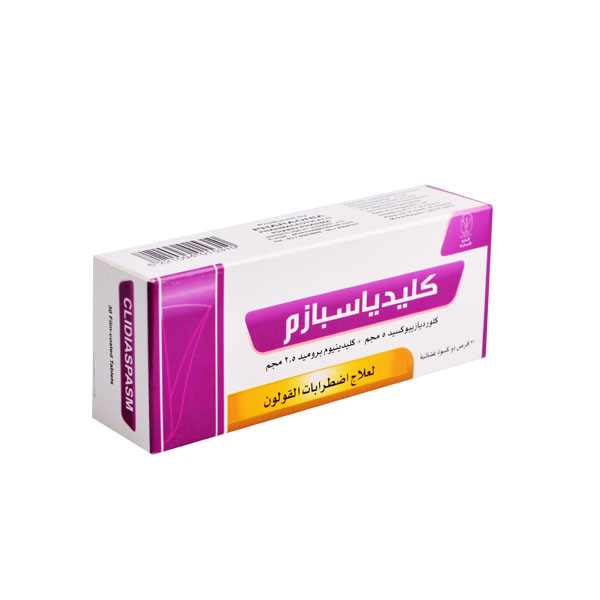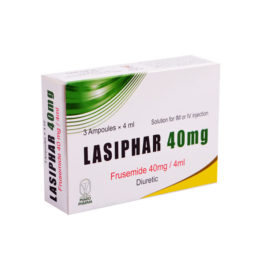Description
Pharmaceutical dosage form:
Film coated tablets.
pharmacological action:
CLIDIASPASM tablets contains Clidinium bromide which is a synthetic anticholingergic agent which has been shown to have spasmodic and antisecretory effect on the gastrointestinal tract. Chlordiazepoxide is an anxiolytic belonging to benzodiazepines. It also possesses sedative, anticonvulsive and myorelaxant properties. Chlorodiazepoxide exerts its activity by inhibiting GABA neurotransmission through binding to specific benzodiazepine receptor sites. This combination may be useful in the treatment of symptomatic manifestations in the GIT related to anxiety
Pharmacokinetics:
ϖ Clidinium bromide is metabolized to methylbromide-1-hydroxy-3-quinobromide clidinium which is the principle form found to be excreted in urine. Clidinium bromide and its metabolite are also found to be excreted in feaces.
ϖ Chlordiazepoxide is metabolized then excreted in urine.
ϖ The half-life is 20 to 24 hours.
ϖ Benzodiazepines cross the placenta barrier and are secreted in milk.
Indications:
Symptomatic treatment of severe anxiolytic manifestations associated with functional digestive troubles including spasms.
dosage:
ϖ The usual dosage in adults: 1 tablet 2 to 4 times per day.
ϖ The doses could be administered during meals, at bedtime or whenever the painful attacks occur.
ϖ In case of elderly, renal or hepatic insufficiency it is recommended to reduce the dose to half.
ϖ The duration of treatment should not exceed 8 to 12 weeks.
Contraindications:
ϖ Risk of closed angle glaucoma.
ϖ Risk of urinary retention due to urethroprostatic troubles.
ϖ Hypersensitivity to the active ingredient or any of the excepients.
ϖ Severe respiratory insufficiency.
ϖ Sleeping apnea syndrome.
ϖ Children less than 14 years old as safety and effectiveness have not been established.
ϖ Severe, acute or chronic hepatic insufficiency.
ϖ Myasthenia.
side effects:
Dry mouth, thickening of bronchial secretions, decreased lacrimal secretions, accommodation disturbances, tachycardia and palpitations, constipation, urinary retention, excitation, irritability mental confusion in elderly, headache, ataxia, insomnia, tension, cutaneous eruptions, diplopia, muscular hypotonia and asthenia.
drug interactions:
Not to be taken with other CNS depressants, Buprenorphines and cimetidine.
Pregnancy & Lactation:
ϖ In case of pregnancy it is contraindicated to use this medication as it may cause congenital anomalie, hyptonia and respiratory distress in the neo-natal.
ϖ Should not to be used in nursing mothers as it decreases the milk secretion and may be secreted in milk.
Precautions & warning:
ϖ The anxiolytic effect of benzodiazepines may decrease in case of administration of the same dose for several weeks.
ϖ The association of several benzodiazepines may increase the risk of pharmacodependence,
ϖ The drug should be used with caution in elderly as it may cause sedation and/or myorelaxant effect.
ϖ The drug should be used with caution in case of coronary insufficiency, rythme disturbance, hyperthyroidism, paralitic ileus, intestinal atony in elderly and toxic megacolon.
ϖ Not to be used in case of vehicle or machinery conduction to avoid the risk of drowsiness.
Packing:
A carton box containing 3 (AL/PVDC) strips, each of 10 film coated tablet with insert leaflet.
Storage:
Keep at a temperature not exceeding 30C, in dry place.
Keep out of reach of children.
instruction to patients:
None.








Reviews
There are no reviews yet.